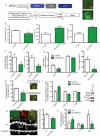REDD1 is essential for stress-induced synaptic loss and depressive behavior
- PMID: 24728411
- PMCID: PMC4016190
- DOI: 10.1038/nm.3513
REDD1 is essential for stress-induced synaptic loss and depressive behavior
Abstract
Major depressive disorder (MDD) affects up to 17% of the population, causing profound personal suffering and economic loss. Clinical and preclinical studies have revealed that prolonged stress and MDD are associated with neuronal atrophy of cortical and limbic brain regions, but the molecular mechanisms underlying these morphological alterations have not yet been identified. Here, we show that stress increases levels of REDD1 (regulated in development and DNA damage responses-1), an inhibitor of mTORC1 (mammalian target of rapamycin complex-1; ref. 10), in rat prefrontal cortex (PFC). This is concurrent with a decrease in phosphorylation of signaling targets of mTORC1, which is implicated in protein synthesis-dependent synaptic plasticity. We also found that REDD1 levels are increased in the postmortem PFC of human subjects with MDD relative to matched controls. Mutant mice with a deletion of the gene encoding REDD1 are resilient to the behavioral, synaptic and mTORC1 signaling deficits caused by chronic unpredictable stress, whereas viral-mediated overexpression of REDD1 in rat PFC is sufficient to cause anxiety- and depressive-like behaviors and neuronal atrophy. Taken together, these postmortem and preclinical findings identify REDD1 as a critical mediator of the atrophy of neurons and depressive behavior caused by chronic stress exposure.
Figures




Comment in
-
Psychiatric disorders: A REDD line from stress to depression.Nat Rev Neurosci. 2014 Jun;15(6):350-1. doi: 10.1038/nrn3749. Epub 2014 Apr 30. Nat Rev Neurosci. 2014. PMID: 24781664 No abstract available.
Similar articles
-
Nutrient-induced stimulation of protein synthesis in mouse skeletal muscle is limited by the mTORC1 repressor REDD1.J Nutr. 2015 Apr;145(4):708-13. doi: 10.3945/jn.114.207621. Epub 2015 Feb 25. J Nutr. 2015. PMID: 25716553 Free PMC article.
-
Disruption of REDD1 gene ameliorates sepsis-induced decrease in mTORC1 signaling but has divergent effects on proteolytic signaling in skeletal muscle.Am J Physiol Endocrinol Metab. 2015 Dec 15;309(12):E981-94. doi: 10.1152/ajpendo.00264.2015. Epub 2015 Oct 20. Am J Physiol Endocrinol Metab. 2015. PMID: 26487002 Free PMC article.
-
REDD1 enhances protein phosphatase 2A-mediated dephosphorylation of Akt to repress mTORC1 signaling.Sci Signal. 2014 Jul 22;7(335):ra68. doi: 10.1126/scisignal.2005103. Sci Signal. 2014. PMID: 25056877 Free PMC article.
-
Emerging role for regulated in development and DNA damage 1 (REDD1) in the regulation of skeletal muscle metabolism.Am J Physiol Endocrinol Metab. 2016 Jul 1;311(1):E157-74. doi: 10.1152/ajpendo.00059.2016. Epub 2016 May 17. Am J Physiol Endocrinol Metab. 2016. PMID: 27189933 Free PMC article. Review.
-
The stress-responsive protein REDD1 and its pathophysiological functions.Exp Mol Med. 2023 Sep;55(9):1933-1944. doi: 10.1038/s12276-023-01056-3. Epub 2023 Sep 1. Exp Mol Med. 2023. PMID: 37653030 Free PMC article. Review.
Cited by
-
Ribosomal protein S6 kinase 1 signaling in prefrontal cortex controls depressive behavior.Proc Natl Acad Sci U S A. 2015 May 12;112(19):6188-93. doi: 10.1073/pnas.1505289112. Epub 2015 Apr 27. Proc Natl Acad Sci U S A. 2015. PMID: 25918363 Free PMC article.
-
Putative Inflammatory Sensitive Mechanisms Underlying Risk or Resilience to Social Stress.Front Behav Neurosci. 2018 Oct 26;12:240. doi: 10.3389/fnbeh.2018.00240. eCollection 2018. Front Behav Neurosci. 2018. PMID: 30416436 Free PMC article. Review.
-
O-GlcNAc transferase in astrocytes modulates depression-related stress susceptibility through glutamatergic synaptic transmission.J Clin Invest. 2023 Apr 3;133(7):e160016. doi: 10.1172/JCI160016. J Clin Invest. 2023. PMID: 36757814 Free PMC article.
-
Transcriptomics of the depressed and PTSD brain.Neurobiol Stress. 2021 Oct 11;15:100408. doi: 10.1016/j.ynstr.2021.100408. eCollection 2021 Nov. Neurobiol Stress. 2021. PMID: 34703849 Free PMC article.
-
Increased Neuronal DNA/RNA Oxidation in the Frontal Cortex of Mice Subjected to Unpredictable Chronic Mild Stress.Chronic Stress (Thousand Oaks). 2017 Jan-Dec;1:2470547017724744. doi: 10.1177/2470547017724744. Epub 2017 Aug 16. Chronic Stress (Thousand Oaks). 2017. PMID: 29250610 Free PMC article.
References
-
- Drevets WC, Price JL, Simpson JR, Todd RD, Reich T, et al. Subgenual prefrontal cortex abnormalities in mood disorders. Nature. 1997;386:824–827. - PubMed
-
- Rajkowska G, Miguel-Hidalgo JJ, Wei J, Dilley G, Pittman SD, et al. Morphometric evidence for neuronal and glial prefrontal cell pathology in major depression. Biol Psychiatry. 1999;45:1085–1098. - PubMed
-
- Radley JJ, Rocher AB, Miller M, Janssen WG, Liston C, et al. Repeated stress induces dendritic spine loss in the rat medial prefrontal cortex. Cereb Cortex. 2006;16:313–320. - PubMed
Publication types
MeSH terms
Substances
Grants and funding
LinkOut - more resources
Full Text Sources
Other Literature Sources
Medical
Molecular Biology Databases
Miscellaneous

